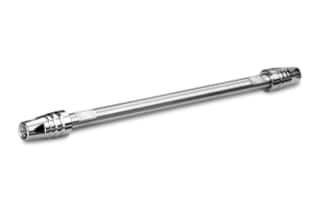
|
Chemistry |
C8 |
|
Separation Mode |
Reversed Phase |
|
Particle Substrate |
Silica |
|
pH Range Min |
2 pH |
|
pH Range Max |
8 pH |
|
Temperature Limits |
45 C |
|
Maximum Pressure |
18000 psi (1240 Bar) |
|
Endcapped |
Yes |
|
Silanol Activity |
Low |
|
Particle Shape |
Spherical |
|
Particle Size |
2.7 µm |
|
Endfitting Type |
Parker-style |
|
Pore Size |
90 Å |
|
Format |
Column |
|
Surface Area |
100 |
|
System |
UHPLC, UPLC |
|
Particle Technology |
Solid Core |
|
USP Classification |
L7 |
|
Inner Diameter |
4.6 mm |
|
Length |
150 mm |
|
Carbon Load |
4.5 % |
|
UNSPSC |
41115709 |
|
Brand |
CORTECS |
|
Product Type |
Columns |
|
Units per Package |
1 pk |
CORTECS C8 Column, 90Å, 2.7 µm, 4.6 mm X 150 mm, 1/pk
CORTECS C8 columns are used for general-purpose method development under low pH test conditions. The C8 ligand within the CORTECS C8 Column is preferred for some assays as it is less hydrophobic in nature and, therefore, less retentive compared to C18 phases.
CORTECS UPLC C8 Columns are designed with solid-core particles having a tri-functionally bonded C8 Ligand. The CORTECS C8 Column is less hydrophobic in contrast to the C18 Ligand in CORTECS UPLC Column Series as it has a smaller alkyl chain. The decreased hydrophobicity of the CORTECS C8 Column leads to decreased retention times of different compounds. This feature is useful for analyzing hydrophobic and extremely hydrophobic analytes such as fat-soluble vitamins.
The CORTECS solid-core particle technology provides some of the highest column efficiencies when they are used with low-dispersive UPLC instrumentation. CORTECS C8 Columns are based on CORTECS 2.7 µm particles which produce sharp, narrower peaks in contrast to fully porous particles of similar size, and one of the best columns to select for increased resolution, speed, and sensitivity.
To view additional offerings available by Waters, please browse through our website or check out brochures to see the complete listings or review equipment compatible with the CORTECS C8 Column. We recommend purchasing equipment directly from our website to ensure you have authentic Waters equipment, and you will also have access to extensive research and details regarding all of Waters products, and you can easily shop for lab equipment as per your laboratory needs.
You might also be interested in the CORTECS C8 VanGuard Cartridge, 90Å, 2.7 µm, 3.9 mm X 5 mm, 3/pk; CORTECS C8 VanGuard Cartridges are used to extend analytical column lifetime and performance by removing particulate contamination from the mobile phase stream. This cartridge is optimized to protect all 4.6 mm I.D. CORTECS C8 analytical columns containing 2.7 µm sorbent particles.
What Does The Term Elution Stand For?
Elution is the chromatographic process of using a solvent to extract an adsorbed substance from a solid adsorbing medium or the removal of antibody from the antigen to which it is attached. In the process, the eluent or eluant is the "carrier" portion of the mobile phase, which moves the analytes through the chromatograph.
What Are The Pressure And pH Limitations Of The CORTECS C8 Column?
This CORTECS C8 Column can withstand pressure up to 18,000 psi (or 1240 Bar) and a maximum temperature of 45 degrees. It also has a pH range of 2 to 8. However, you should note that working at the extremes of pressures, pH, and/or temperatures will result in shorter column lifetimes and effectiveness.